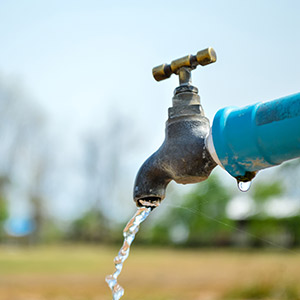Have a Frozen Pipe? Here’s What You Need to Do
Cooler temperatures came early this year to Baton Rouge near the end of October. There was even a hard freeze warning in early November – weeks before Thanksgiving and an entire month before the official start of winter. With a hard freeze, you may find slippery patches of ice on the road, damage to your plants, and even that your pipes have frozen.
In the event of another hard freeze in Baton Rouge, it is important that you take the necessary steps to prevent your pipes from bursting if they do freeze. Although some frozen pipes can thaw on their own, it isn’t worth risking. Pipe bursts can lead to costly repairs and significant water damage. So be sure you are prepared to thaw your pipes quickly and correctly with our tips.
Finding a Frozen Pipe
As plumbers, we can identify any frozen pipes in your home by looking at their outer appearance. You can generally tell as well. If they appear expanded or frosted over then they are most likely frozen. However, not all of your pipes will be exposed for you to inspect. One indication that you have a frozen pipe is when your faucets lack a steady flow of water. Another indication is when your toilets do not refill after flushing.
Remember, if one pipe is frozen, there is a strong chance that other pipes are frozen too. So, if the exposed pipes are freezing, the pipes under your home or in the walls could also be frozen.
Thawing Your Home’s Frozen Pipes
For the frozen pipes that you can see, there are very important steps that you must closely follow to begin the defrosting process. If you do not thaw your pipes correctly, they could burst due to the pressure of the ice.
- Turn on your faucets. Moving water helps with thawing process and will relieve the pressure in the pipe. This is why it is advised to have your faucet turned on to a slow drip when a freeze warning is issued.
- Turn on the heater. Most homeowners will probably already have the heater on if it’s cold outside, but be sure you have it on if your pipes are starting to freeze. This will allow the warm air to circulate around your home and warm up the pipes within the walls.
- Open the cabinets. Letting warm air circulate inside the cabinets will help warm up the pipes and melt any ice. Be sure that any chemicals or cleaning products inside the cabinets are hidden away from pets and children.
- Apply heat to the pipes. Use towels soaked in hot water or a hair dryer to thaw out the pipes. Start with the top where the faucet is and gradually work your way down.
- DO NOT start at the frozen section of the pipe.
- Never under any circumstance use a propane torch or any open flame to thaw your pipes. It is not only ineffective but it will also damage your plumbing system.
- If you do use a hair dryer or heater to thaw out your pipes, be very careful that the electronics do not get wet or start a fire.
- If a pipe does burst, turn off the water supply immediately. The location of the panel to your home’s water supply will depend on the layout of your home. Be sure you know where your main water shutoff is located before taking any actions to prevent any costly water damage repairs.
Prevention is Always Better Than Reaction
The next time there is a freeze warning, take the following necessary steps to prevent your pipes from freezing:
- Keep the heater on
- Have your cabinet doors open so warm air can circulate inside
- Close the garage door
- Allow a small drip from the faucets to prevent any pressure buildup
- Make sure your home and crawlspaces are properly insulated
- Be sure to also insulate exposed piping outside of your home, under the pier house, and in the attic
For Further Help with Your Plumbing or Piping System, Call Central Plumbing
With 24/7 emergency plumbing service, our licensed, bonded, and insured plumbers at Central Plumbing are always ready to help. Whether you need help insulating your pipes or help with a frozen pipe. Be sure to take care of your pipes this winter season and call us if you suspect any water leaks or pipe bursts.





